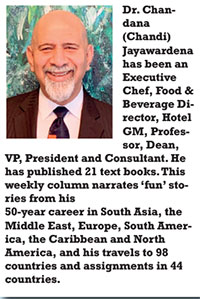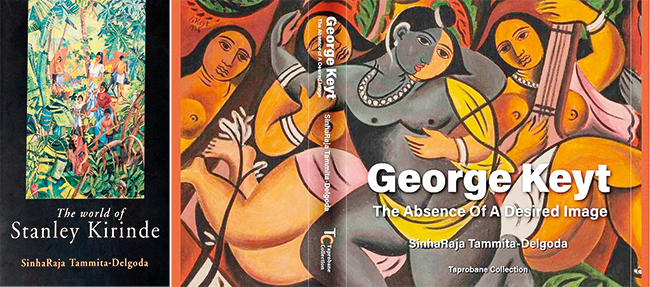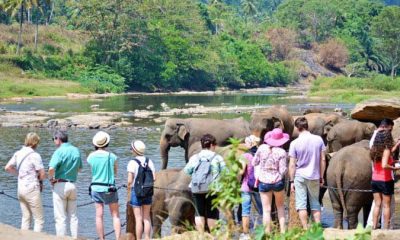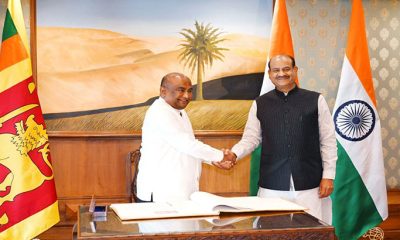Features
Dr. SinhaRaja Tammita-Delgoda Art Historian, Adventurer, Author, and Renaissance Man
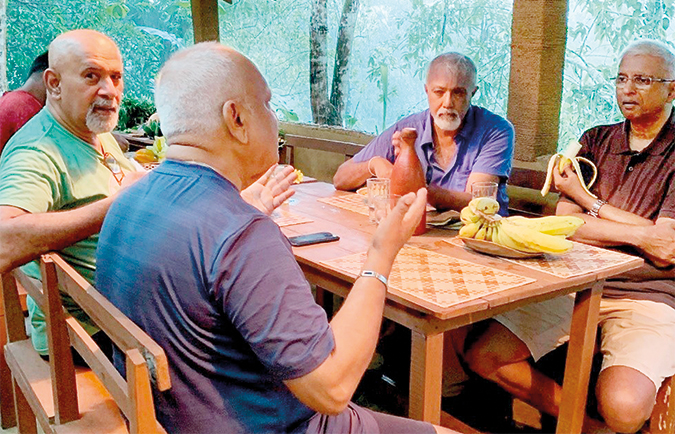
PLACES, PEOPLE & PASSIONS (3Ps)
Dr. Chandana (Chandi) Jayawardena DPhil
President – Chandi J. Associates Inc. Consulting, Canada
chandij@sympatico.ca
Profile
SinhaRaja is an explorer and an adventurer who has lived in war zones and reported on wars; he has explored jungles and climbed in the Hindu Kush. Historian, art historian, academic and author, he has produced some of the most important studies in recent years on the art, history, and culture of Sri Lanka. He has also enacted some of its greatest dance rituals and taught the first university course in the west on Sri Lankan Art and Architecture. His first film, the story of an expedition ‘In Search of the Malwatu Oya’, has won five international awards.
SLITHM Graduation 2023 & ‘karandu Atha’
On April 20, 2023. I was seated at a corner of the front row at the BMICH National Convention Centre, with a few veteran hoteliers. We were waiting for the Minister of Tourism to arrive as the chief guest of the annual graduation ceremony of Sri Lanka Institute of Tourism and Hotel Management (SLITHM). Most of the 1,500 seats of the main auditorium were full of relatives of the new graduands, their happy parents and tourism industry leaders.
Getting bored with the long delay, my hotel industry colleague seated next to me, Gemunu Goonewardena, started talking about the roles of elephants in Sri Lanka. “Professor, do you know that elephants working hard in the fields are not used to perform religious tasks like carrying the caskets at pageants?” Annoyed with the delay in commencing the event as advertised, I did not pay much attention to Gemunu’s remark.
“Is that so?”, I made unenthusiastic response. “Yes. For an example, the famous Maligawa tusker Raja of the Temple of the Tooth in Kandy, had very little work to do, except during the annual Kandy Perahera in August. Such tuskers are called with respect, ‘Karandu Atha’” — Gemunu continued to show his knowledge about elephants and our culture.
At that moment I was happy to see the large screen on the stage displaying the arrival of the chief guest and other VIPs welcomed at the entrance and ushered by the Chairman of SLITHM. Kandyan dancers and drummers were performing in front of the slow-moving VIP procession. “Look, the chief guest, that gentleman garlanded with orchids, is not the minister!” Gemunu alerted us.
Apparently, as the minister was too busy to attend the event, SLITHM had arranged a last minute substitute as the chief guest. This gentleman wore a white suit (which reminded me of the prefect’s attire for ceremonies at boys’ schools in Ceylon in 1960s). He appeared prominent among all other VIPs in dark suits, looking distinguished and walking like a king, serious, without a smile on his face. “Professor, look at him. That gentleman is certainly like a ‘Karandu Atha’!”, Gemunu whispered to my ear. I agreed.
A Keynote Speaker Par Excellence
None of veteran hoteliers seated in my row knew of this gentleman – Dr. SinhaRaja Tammita-Delgoda – but we were impressed when he was introduced as an Art Historian, Author, Lecturer, Public Speaker, Academic, Writer, and an award-winning Film-maker. We were even more impressed with his keynote speech – well prepared and well delivered, with a passion. I also liked his given name, the same as the greatest rainforest in Sri Lanka, which is steeped in deep legend and mystery, and since 1988, protected as an UNESCO World Heritage Site. I soon realised that, like the Sinharaja Rainforest, Dr. SinhaRaja Tammita-Delgoda had a mystic personality, which was not easy to analyse.
After nearly four-hours, when the graduation event ended, a few of us were invited to a post-event reception. When I saw the keynote speaker at this reception held in a very small meeting room, attended by about 50 VIPs, I was happy. He was surrounded by a few Colombo socialites who were picking Dr. SinhaRaja Tammita-Delgoda’s brains about topics related to their commercial interests, and close to his heart – horse-riding, eco-tourism, and indigenous food of Sri Lanka.
“Come on, Gemunu, let’s meet this interesting guy.” I approached him with some difficulty. Soon after we introduced ourselves, he introduced the ladies surrounding him to us. Although they were interesting, after greeting them quickly, I zoomed into have a good one-on-one chat with him. I broke the ice with a genuine compliment: “Dr. SinhaRaja Tammita-Delgoda, you delivered an excellent keynote.
Well done! I was inspired by your speech.” I He smiled and said, “Please call me SinhaRaja.” I was thinking that his name was quite a mouthful. Double barrel names are unusual in Sri Lanka, but he is an unusual person. Accomplished and versatile… in fact, truly a Renaissance Man!
After a five-minute chat, owing to some common interests such as art, history, writing, public speaking, lecturing and cinema, we clicked and mutually enjoyed our brief chat. He also liked when I joked about how Gemunu compared him to a ‘Karandu Atha’. Before we parted, we agreed to meet again prior to my return to Canada. Gemunu invited SinhaRaja to join me and two mutual friends for a full-day excursion to ‘Ceylon Culinary Trail’ in Ingiriya in a week’s time, just before my departure from Sri Lanka. SinhaRaja promptly accepted.
The very next day, I shared the links to some of my recent publications with him, and in return, SinhaRaja e-mailed Gemunu and me some links showcasing his recent work, including a YouTube file of his 2019 film: ‘In Search of the Malwatu Oya’ which was an artistic documentary about an adventurous 164-kilometre journey he took on the second longest river in Sri Lanka with a few other adventurers. Starting from the holy mountain of Ritigala, they travelled to the heart of an ancient civilization, the Raja Rata (Land of the Kings) to enter the Bay of Mannar of the Indian Ocean. It is the story of Sri Lanka’s most historic river and the beginning of an ancient civilization. I was not surprised it won five international awards.
‘Ceylon Culinary Trail’ Experience in Ingiriya
A week later, we commenced our trip to Ingiriya early in the morning picking up SinhaRaja at his house near Kotte. Our discussions in the car covered many interesting topics, including poetry. He was thankful when I presented a signed copy of my latest published work: ‘Emotions’ a book of visual poetry. When we arrived at Ingiriya, I realized that Sinharaja was familiar with the customs and rituals of the village, far better than other excursionists there.
After the welcome, and breakfast including dishes made with rare local ingredients, we were taken on a guided tour along a village trail through a rubber plantation. I then realized that SinhaRaja was much physically fitter than the rest of the group from Colombo and Canada! Despite a couple of breaks and drinking some refreshing young and king coconuts in between, we were exhausted by the time we returned to our base in Ingiriya. It was a hot and humid day.
“Sir, you will certainly feel better if you have a dip in this natural pool” – our guide (the husband of the host and cook) showed us a beautiful bathing spot connected to a gently flowing stream towards the Kalu Ganga. Without wasting any time, SinhaRaja got into the water, and we followed him. That cool water and toddy served to make us hungry for a highly anticipated lunch prepared with some ingredients previously unknown to the members of our group.
Topics of Conversation
Over a tasty authentic lunch experience enhanced by singing of old songs and folk poems by our lady host, we did not feel the time pass by. After lunch we engaged in a long conversation about various topics. SinhaRaja listened to our views more than expressing his own. We stayed there chatting for a long time through a sudden welcome downpour that lasted till early evening. It was a wonderful day with some great food for the belly and food for thought.
On our way back to Colombo SinhaRaja and I talked about some common aspects of our lives, the times we both lived and studied in England. I did my three levels of post-secondary education in England over a few decades with long breaks in between. In his case, SinghaRaja has done his bachelor’s, master’s, and doctoral degrees at one go! That was impressive, but I was more fascinated when he told me: “I never went to primary, middle, or upper school. I was home-schooled.”
SinhaRaja was surprised to hear that I was a special apprentice at the Dorchester under the great Chef Anton Mosimann. He was even more surprised to hear that I was a management observer at Le Meridien Piccadilly in London and that hotel’s two-Michelin star restaurant – Oak Room. “I used to dine in that restaurant with a girlfriend during my doctoral studies at the King’s College” he confided.
Our last topic of conversation that day was my wine and spirits studies in Europe. Just before we dropped him off at his house, he was asking me questions about my studies on whisky production in Scotland in 1982, when I was on a UN/ILO Fellowship. “I have a very old bottle of an expensive Japanese whisky, at home, which I’d like to taste with you.” He invited me home. “I was an expert 40 years ago… I don’t drink too much now.” I told him. “I insist my friend. Be my guest!” he persuaded me to spend an hour in his house looking at his collection of books, paintings, and old photographs. The Japanese whisky was also great. After that we kept in touch regularly and I sent him ten questions for this article:
Q: Out of all the places you have visited in Sri Lanka and overseas, what is your favourite and most interesting place?
A: One of the more interesting experiences was journeying to the dry, dusty teak forests of
Western India in search of the Asian Lion. The Gir Forest, in Gujarat, is the home of the
Asian Lion which once roamed the whole of Asia. Hunted to extinction under the British,
Asian Lions were preserved by an Indian prince, in a remote corner of Western India, still relatively unknown.
Q: Out of all the inspiring people you have met, who inspired you most to become an explorer and an adventurer?
A: Nihal Fernando, Sri Lanka’s greatest photographer. He and his protegee, Luxshman Nadaraja, taught me to see the land, instead of just thinking about it. Through Nihal Fernando I learned that Sri Lankan civilization, its art and architecture was inextricably linked to its environment. One cannot see one without the other.
Q: What was the most memorable experience you had during your undergraduate, graduate and doctoral studies in the United Kingdom?
A: Driving a MG Roadster Classic sports car with the top down in winter. It was memorable
because it gave me pneumonia. The other was being held by my arms and legs by four English thugs, who sang “Michael Row the Boat Ashore” as they banged my head against a car. I was saved by an old lady who attacked them with her umbrella. My other formative memory is discovering the work of Sri Lanka’s two great art historians – Ananda Coomaraswamy and Senake Bandaranayake in the library at the School of Oriental and African Studies.
Q: What was the most challenging experience you had as a Visiting Fulbright Scholar in the USA?
A: Being stopped at Madison airport by security because I was wearing cufflinks. As the alarms went off, everyone screamed “he has metal in his shirt” and pointed their guns
at me. I had to take the cufflinks off and roll them across the floor. Afterwards, they asked me, “What are they for, why are you wearing them”. I said: “To hold my sleeves together” They felt sorry for me. “Son, this is America. We have buttons here!”
Q: As a student of the early phases of British expansion in India during the 18th century, can you single out one main scholarly contribution you have made to the body of knowledge?
A: I made a study of one of the first Englishman to write a history of India.
Q: What were your main discoveries during your time at Ridi Vihare to study medieval Sinhalese culture?
A: Apart from patience, self-control, and self-discipline, I also learned to appreciate Kandyan Art. I grew to realize that it was not “folk art” and began to see it for what it was, a form of miniature painting: meticulous, precise, and controlled.
Q: What was the most challenging experience you had as a reporter during the final stages of Eelam War IV?
A: Trying not to jump into the air when explosions went off near me. The challenge was trying not to show terror in front of men who coped with fear every day.
Q: Can you explain the inspiration for and the most memorable experience during the making of ‘In Search of Malwatu Oya’?
A: The inspiration was the magic of the unknown, of going back into time. Memorable, as we were travelling in long canoes. I have never been so close to so many crocodiles for so long.
Q: What were the different approaches you took in producing two of the great works on Stanley Kirinde and George Keyt?
A: Both are huge ambitious works of art and scholarship. One project was hugely thorough and had great resources behind it. The other was done at the height of Covid, the Aragalaya, a time of no power, no fuel, no food, no order and now, no money.
Keyt was an outsider and a rebel. Kirinde was an insider and like most insiders, he was conservative and more conformist. Kirinde was part of an ancient culture and a living civilization. Keyt was the product of a recent and derivative colonial culture. At a time when colonial culture was dominant, Keyt went out of his way to reject it and embrace a totally different world. This makes him quite unique.
As there have been many studies on Keyt, our objective was to show works of art which were not published before, and which were not widely known. At the same time, we sought to look closely at the influences behind Keyt’s life and art which have not been so well studied and are not so well known.
With Kirinde, almost everyone went out of their way to help. With Keyt it was different. Great international auction houses and collectors all over the world went out of their way to help. However, in Sri Lanka two local organizations went out of their way not to help. One was an organization associated with the legacy of George Keyt, the other was an organization associated with the legacy of Lionel Wendt. Needless to say, both organizations have gone out of their way to assist and work with foreign scholars and experts.
Q: You told me that you do not like to use the term: ‘coffee table books’ in describing your works on Stanley Kirinde and George Keyt. Why?
A: History of Art is a serious intellectual and scholastic discipline, which entails the study and analysis of the visual arts. It seeks to understand art, sculpture, architecture, craft, and decoration, in their cultural and historic context.
The term coffee table is used mainly in Sri Lanka because people do not like to read. Sri Lankans generally prefer books with pictures which they can glance through without too much effort. They then keep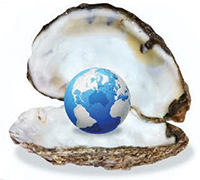 them on long low tables for everyone to see. That is why we call them coffee table books. In the rest of the subcontinent, people not only look at the pictures, but they also read about them and think about them.
them on long low tables for everyone to see. That is why we call them coffee table books. In the rest of the subcontinent, people not only look at the pictures, but they also read about them and think about them.
Next week, 3Ps will feature a Lawyer, CEO, and a Tourism Visionary …
Features
The heart-friendly health minister

by Dr Gotabhya Ranasinghe
Senior Consultant Cardiologist
National Hospital Sri Lanka
When we sought a meeting with Hon Dr. Ramesh Pathirana, Minister of Health, he graciously cleared his busy schedule to accommodate us. Renowned for his attentive listening and deep understanding, Minister Pathirana is dedicated to advancing the health sector. His openness and transparency exemplify the qualities of an exemplary politician and minister.
Dr. Palitha Mahipala, the current Health Secretary, demonstrates both commendable enthusiasm and unwavering support. This combination of attributes makes him a highly compatible colleague for the esteemed Minister of Health.
Our discussion centered on a project that has been in the works for the past 30 years, one that no other minister had managed to advance.
Minister Pathirana, however, recognized the project’s significance and its potential to revolutionize care for heart patients.
The project involves the construction of a state-of-the-art facility at the premises of the National Hospital Colombo. The project’s location within the premises of the National Hospital underscores its importance and relevance to the healthcare infrastructure of the nation.
This facility will include a cardiology building and a tertiary care center, equipped with the latest technology to handle and treat all types of heart-related conditions and surgeries.
Securing funding was a major milestone for this initiative. Minister Pathirana successfully obtained approval for a $40 billion loan from the Asian Development Bank. With the funding in place, the foundation stone is scheduled to be laid in September this year, and construction will begin in January 2025.
This project guarantees a consistent and uninterrupted supply of stents and related medications for heart patients. As a result, patients will have timely access to essential medical supplies during their treatment and recovery. By securing these critical resources, the project aims to enhance patient outcomes, minimize treatment delays, and maintain the highest standards of cardiac care.
Upon its fruition, this monumental building will serve as a beacon of hope and healing, symbolizing the unwavering dedication to improving patient outcomes and fostering a healthier society.We anticipate a future marked by significant progress and positive outcomes in Sri Lanka’s cardiovascular treatment landscape within the foreseeable timeframe.
Features
A LOVING TRIBUTE TO JESUIT FR. ALOYSIUS PIERIS ON HIS 90th BIRTHDAY

by Fr. Emmanuel Fernando, OMI
Jesuit Fr. Aloysius Pieris (affectionately called Fr. Aloy) celebrated his 90th birthday on April 9, 2024 and I, as the editor of our Oblate Journal, THE MISSIONARY OBLATE had gone to press by that time. Immediately I decided to publish an article, appreciating the untiring selfless services he continues to offer for inter-Faith dialogue, the renewal of the Catholic Church, his concern for the poor and the suffering Sri Lankan masses and to me, the present writer.
It was in 1988, when I was appointed Director of the Oblate Scholastics at Ampitiya by the then Oblate Provincial Fr. Anselm Silva, that I came to know Fr. Aloy more closely. Knowing well his expertise in matters spiritual, theological, Indological and pastoral, and with the collaborative spirit of my companion-formators, our Oblate Scholastics were sent to Tulana, the Research and Encounter Centre, Kelaniya, of which he is the Founder-Director, for ‘exposure-programmes’ on matters spiritual, biblical, theological and pastoral. Some of these dimensions according to my view and that of my companion-formators, were not available at the National Seminary, Ampitiya.
Ever since that time, our Oblate formators/ accompaniers at the Oblate Scholasticate, Ampitiya , have continued to send our Oblate Scholastics to Tulana Centre for deepening their insights and convictions regarding matters needed to serve the people in today’s context. Fr. Aloy also had tried very enthusiastically with the Oblate team headed by Frs. Oswald Firth and Clement Waidyasekara to begin a Theologate, directed by the Religious Congregations in Sri Lanka, for the contextual formation/ accompaniment of their members. It should very well be a desired goal of the Leaders / Provincials of the Religious Congregations.
Besides being a formator/accompanier at the Oblate Scholasticate, I was entrusted also with the task of editing and publishing our Oblate journal, ‘The Missionary Oblate’. To maintain the quality of the journal I continue to depend on Fr. Aloy for his thought-provoking and stimulating articles on Biblical Spirituality, Biblical Theology and Ecclesiology. I am very grateful to him for his generous assistance. Of late, his writings on renewal of the Church, initiated by Pope St. John XX111 and continued by Pope Francis through the Synodal path, published in our Oblate journal, enable our readers to focus their attention also on the needed renewal in the Catholic Church in Sri Lanka. Fr. Aloy appreciated very much the Synodal path adopted by the Jesuit Pope Francis for the renewal of the Church, rooted very much on prayerful discernment. In my Religious and presbyteral life, Fr.Aloy continues to be my spiritual animator / guide and ongoing formator / acccompanier.
Fr. Aloysius Pieris, BA Hons (Lond), LPh (SHC, India), STL (PFT, Naples), PhD (SLU/VC), ThD (Tilburg), D.Ltt (KU), has been one of the eminent Asian theologians well recognized internationally and one who has lectured and held visiting chairs in many universities both in the West and in the East. Many members of Religious Congregations from Asian countries have benefited from his lectures and guidance in the East Asian Pastoral Institute (EAPI) in Manila, Philippines. He had been a Theologian consulted by the Federation of Asian Bishops’ Conferences for many years. During his professorship at the Gregorian University in Rome, he was called to be a member of a special group of advisers on other religions consulted by Pope Paul VI.
Fr. Aloy is the author of more than 30 books and well over 500 Research Papers. Some of his books and articles have been translated and published in several countries. Among those books, one can find the following: 1) The Genesis of an Asian Theology of Liberation (An Autobiographical Excursus on the Art of Theologising in Asia, 2) An Asian Theology of Liberation, 3) Providential Timeliness of Vatican 11 (a long-overdue halt to a scandalous millennium, 4) Give Vatican 11 a chance, 5) Leadership in the Church, 6) Relishing our faith in working for justice (Themes for study and discussion), 7) A Message meant mainly, not exclusively for Jesuits (Background information necessary for helping Francis renew the Church), 8) Lent in Lanka (Reflections and Resolutions, 9) Love meets wisdom (A Christian Experience of Buddhism, 10) Fire and Water 11) God’s Reign for God’s poor, 12) Our Unhiddden Agenda (How we Jesuits work, pray and form our men). He is also the Editor of two journals, Vagdevi, Journal of Religious Reflection and Dialogue, New Series.
Fr. Aloy has a BA in Pali and Sanskrit from the University of London and a Ph.D in Buddhist Philosophy from the University of Sri Lankan, Vidyodaya Campus. On Nov. 23, 2019, he was awarded the prestigious honorary Doctorate of Literature (D.Litt) by the Chancellor of the University of Kelaniya, the Most Venerable Welamitiyawe Dharmakirthi Sri Kusala Dhamma Thera.
Fr. Aloy continues to be a promoter of Gospel values and virtues. Justice as a constitutive dimension of love and social concern for the downtrodden masses are very much noted in his life and work. He had very much appreciated the commitment of the late Fr. Joseph (Joe) Fernando, the National Director of the Social and Economic Centre (SEDEC) for the poor.
In Sri Lanka, a few religious Congregations – the Good Shepherd Sisters, the Christian Brothers, the Marist Brothers and the Oblates – have invited him to animate their members especially during their Provincial Congresses, Chapters and International Conferences. The mainline Christian Churches also have sought his advice and followed his seminars. I, for one, regret very much, that the Sri Lankan authorities of the Catholic Church –today’s Hierarchy—- have not sought Fr.
Aloy’s expertise for the renewal of the Catholic Church in Sri Lanka and thus have not benefited from the immense store of wisdom and insight that he can offer to our local Church while the Sri Lankan bishops who governed the Catholic church in the immediate aftermath of the Second Vatican Council (Edmund Fernando OMI, Anthony de Saram, Leo Nanayakkara OSB, Frank Marcus Fernando, Paul Perera,) visited him and consulted him on many matters. Among the Tamil Bishops, Bishop Rayappu Joseph was keeping close contact with him and Bishop J. Deogupillai hosted him and his team visiting him after the horrible Black July massacre of Tamils.
Features
A fairy tale, success or debacle

Sri Lanka-Singapore Free Trade Agreement
By Gomi Senadhira
senadhiragomi@gmail.com
“You might tell fairy tales, but the progress of a country cannot be achieved through such narratives. A country cannot be developed by making false promises. The country moved backward because of the electoral promises made by political parties throughout time. We have witnessed that the ultimate result of this is the country becoming bankrupt. Unfortunately, many segments of the population have not come to realize this yet.” – President Ranil Wickremesinghe, 2024 Budget speech
Any Sri Lankan would agree with the above words of President Wickremesinghe on the false promises our politicians and officials make and the fairy tales they narrate which bankrupted this country. So, to understand this, let’s look at one such fairy tale with lots of false promises; Ranil Wickremesinghe’s greatest achievement in the area of international trade and investment promotion during the Yahapalana period, Sri Lanka-Singapore Free Trade Agreement (SLSFTA).
It is appropriate and timely to do it now as Finance Minister Wickremesinghe has just presented to parliament a bill on the National Policy on Economic Transformation which includes the establishment of an Office for International Trade and the Sri Lanka Institute of Economics and International Trade.
Was SLSFTA a “Cleverly negotiated Free Trade Agreement” as stated by the (former) Minister of Development Strategies and International Trade Malik Samarawickrama during the Parliamentary Debate on the SLSFTA in July 2018, or a colossal blunder covered up with lies, false promises, and fairy tales? After SLSFTA was signed there were a number of fairy tales published on this agreement by the Ministry of Development Strategies and International, Institute of Policy Studies, and others.
However, for this article, I would like to limit my comments to the speech by Minister Samarawickrama during the Parliamentary Debate, and the two most important areas in the agreement which were covered up with lies, fairy tales, and false promises, namely: revenue loss for Sri Lanka and Investment from Singapore. On the other important area, “Waste products dumping” I do not want to comment here as I have written extensively on the issue.
1. The revenue loss
During the Parliamentary Debate in July 2018, Minister Samarawickrama stated “…. let me reiterate that this FTA with Singapore has been very cleverly negotiated by us…. The liberalisation programme under this FTA has been carefully designed to have the least impact on domestic industry and revenue collection. We have included all revenue sensitive items in the negative list of items which will not be subject to removal of tariff. Therefore, 97.8% revenue from Customs duty is protected. Our tariff liberalisation will take place over a period of 12-15 years! In fact, the revenue earned through tariffs on goods imported from Singapore last year was Rs. 35 billion.
The revenue loss for over the next 15 years due to the FTA is only Rs. 733 million– which when annualised, on average, is just Rs. 51 million. That is just 0.14% per year! So anyone who claims the Singapore FTA causes revenue loss to the Government cannot do basic arithmetic! Mr. Speaker, in conclusion, I call on my fellow members of this House – don’t mislead the public with baseless criticism that is not grounded in facts. Don’t look at petty politics and use these issues for your own political survival.”
I was surprised to read the minister’s speech because an article published in January 2018 in “The Straits Times“, based on information released by the Singaporean Negotiators stated, “…. With the FTA, tariff savings for Singapore exports are estimated to hit $10 million annually“.
As the annual tariff savings (that is the revenue loss for Sri Lanka) calculated by the Singaporean Negotiators, Singaporean $ 10 million (Sri Lankan rupees 1,200 million in 2018) was way above the rupees’ 733 million revenue loss for 15 years estimated by the Sri Lankan negotiators, it was clear to any observer that one of the parties to the agreement had not done the basic arithmetic!
Six years later, according to a report published by “The Morning” newspaper, speaking at the Committee on Public Finance (COPF) on 7th May 2024, Mr Samarawickrama’s chief trade negotiator K.J. Weerasinghehad had admitted “…. that forecasted revenue loss for the Government of Sri Lanka through the Singapore FTA is Rs. 450 million in 2023 and Rs. 1.3 billion in 2024.”
If these numbers are correct, as tariff liberalisation under the SLSFTA has just started, we will pass Rs 2 billion very soon. Then, the question is how Sri Lanka’s trade negotiators made such a colossal blunder. Didn’t they do their basic arithmetic? If they didn’t know how to do basic arithmetic they should have at least done their basic readings. For example, the headline of the article published in The Straits Times in January 2018 was “Singapore, Sri Lanka sign FTA, annual savings of $10m expected”.
Anyway, as Sri Lanka’s chief negotiator reiterated at the COPF meeting that “…. since 99% of the tariffs in Singapore have zero rates of duty, Sri Lanka has agreed on 80% tariff liberalisation over a period of 15 years while expecting Singapore investments to address the imbalance in trade,” let’s turn towards investment.
Investment from Singapore
In July 2018, speaking during the Parliamentary Debate on the FTA this is what Minister Malik Samarawickrama stated on investment from Singapore, “Already, thanks to this FTA, in just the past two-and-a-half months since the agreement came into effect we have received a proposal from Singapore for investment amounting to $ 14.8 billion in an oil refinery for export of petroleum products. In addition, we have proposals for a steel manufacturing plant for exports ($ 1 billion investment), flour milling plant ($ 50 million), sugar refinery ($ 200 million). This adds up to more than $ 16.05 billion in the pipeline on these projects alone.
And all of these projects will create thousands of more jobs for our people. In principle approval has already been granted by the BOI and the investors are awaiting the release of land the environmental approvals to commence the project.
I request the Opposition and those with vested interests to change their narrow-minded thinking and join us to develop our country. We must always look at what is best for the whole community, not just the few who may oppose. We owe it to our people to courageously take decisions that will change their lives for the better.”
According to the media report I quoted earlier, speaking at the Committee on Public Finance (COPF) Chief Negotiator Weerasinghe has admitted that Sri Lanka was not happy with overall Singapore investments that have come in the past few years in return for the trade liberalisation under the Singapore-Sri Lanka Free Trade Agreement. He has added that between 2021 and 2023 the total investment from Singapore had been around $162 million!
What happened to those projects worth $16 billion negotiated, thanks to the SLSFTA, in just the two-and-a-half months after the agreement came into effect and approved by the BOI? I do not know about the steel manufacturing plant for exports ($ 1 billion investment), flour milling plant ($ 50 million) and sugar refinery ($ 200 million).
However, story of the multibillion-dollar investment in the Petroleum Refinery unfolded in a manner that would qualify it as the best fairy tale with false promises presented by our politicians and the officials, prior to 2019 elections.
Though many Sri Lankans got to know, through the media which repeatedly highlighted a plethora of issues surrounding the project and the questionable credentials of the Singaporean investor, the construction work on the Mirrijiwela Oil Refinery along with the cement factory began on the24th of March 2019 with a bang and Minister Ranil Wickremesinghe and his ministers along with the foreign and local dignitaries laid the foundation stones.
That was few months before the 2019 Presidential elections. Inaugurating the construction work Prime Minister Ranil Wickremesinghe said the projects will create thousands of job opportunities in the area and surrounding districts.
The oil refinery, which was to be built over 200 acres of land, with the capacity to refine 200,000 barrels of crude oil per day, was to generate US$7 billion of exports and create 1,500 direct and 3,000 indirect jobs. The construction of the refinery was to be completed in 44 months. Four years later, in August 2023 the Cabinet of Ministers approved the proposal presented by President Ranil Wickremesinghe to cancel the agreement with the investors of the refinery as the project has not been implemented! Can they explain to the country how much money was wasted to produce that fairy tale?
It is obvious that the President, ministers, and officials had made huge blunders and had deliberately misled the public and the parliament on the revenue loss and potential investment from SLSFTA with fairy tales and false promises.
As the president himself said, a country cannot be developed by making false promises or with fairy tales and these false promises and fairy tales had bankrupted the country. “Unfortunately, many segments of the population have not come to realize this yet”.
(The writer, a specialist and an activist on trade and development issues . )

